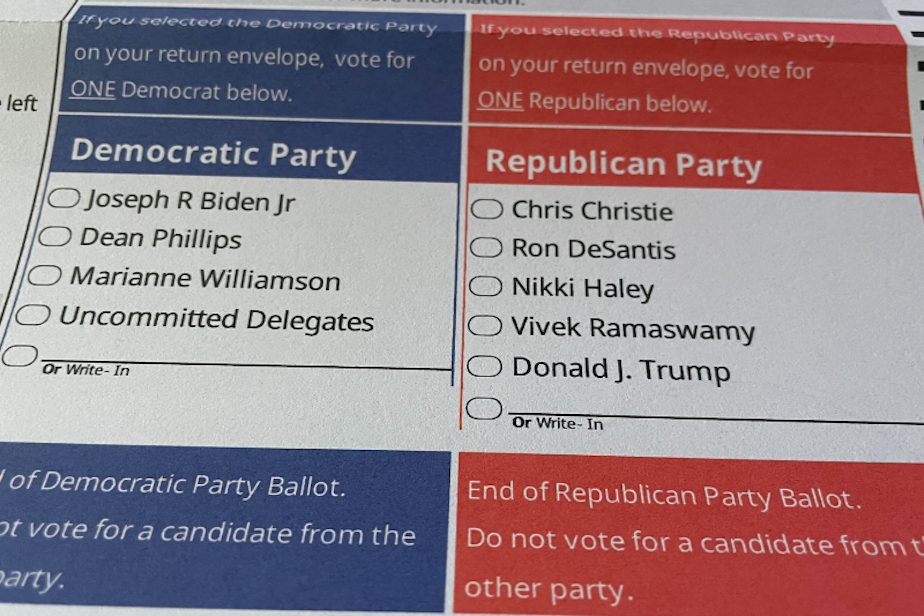'Deepfakes' want to sway your vote. Here’s how to spot them

Thousands of voters in New Hampshire received voicemails last month with a recorded message from President Joe Biden. It’s nothing out of the ordinary in a big election year. There’s just one problem: The audio they heard was fake.
As the presidential election heats up, “deepfakes” — audio, images, and video generated by artificial intelligence, or AI — are already spreading misinformation and causing confusion.
“Deepfakes have become so easy and so cheap to generate, it’s a potential threat to our electoral system, [a] potential threat to our democracy,” said Oren Etzioni, an AI researcher and founder of TrueMedia.org, a nonprofit designing tools to detect deepfakes.
RELATED: Washington state braces for deepfakes ahead of 2024 elections
The technology’s potential to disrupt the 2024 election is top of mind for Washington Secretary of State Steve Hobbs. He said he’s particularly concerned about deepfakes spreading misinformation about how and when to vote.
“You can have a digital image of, let's say, myself… that's telling you, ‘Hey, you can vote later,’” Hobbs said.
Deepfakes have already been deployed to influence recent elections in Slovakia and Indonesia, and foreign actors, particularly Russia, have attempted to influence American voters in past high-profile elections.
Sponsored
RELATED: Stand With The Facts
Given how cheap and easy the technology has become in the past few years, elections officials believe local races will also be targeted this year.
Foreign actors “will look at congressional races, because that affects Congress, and which way you're going to support a certain policy. But they'll also look at local races, because anytime you can cause confusion or disruption within the election, it affects all the races up and down the ballot,” Hobbs said.

Here are a few ways experts say you can spot a fake image or video. But beware: AI technology is evolving quickly, and some of these clues are already disappearing from deepfakes.
Sponsored
Step 1: Pause.
Before sharing or interacting with a piece of media, take a moment to step back from it. Ask yourself: Does anything seem off about what I’m seeing?
“I think trusting your gut in this case is probably the most powerful tool we have,” said Jevin West, an associate professor at the University of Washington who studies misinformation. He helped create a resource called “Which Face Is Real?” to identify AI-generated images.
RELATED: Why misinformation is 'sticky' and sometimes easy to fall for
If you're gut says something isn't right or is too preposterous, don't share it, he said.
Sponsored
That’s when you should pause and consider whether what you’re seeing is real.
“If you see something and you're outraged or upset or angry, any of those strong emotions, that's the time where you're most inclined to forward it to a bunch of friends,” said artificial intelligence researcher Oren Etzioni.
Take a closer look.
Step 2: Check hands and hair.
As convincing as deepfakes sometimes are, the images they generate struggle to replicate the real world in specific ways.
Sponsored
Hands are one common issue. Many deepfakes give the people they generate too many or too few fingers, like in the viral deepfake of Pope Francis wearing a white puffer coat.
Hair is another challenge for AI systems that generate deepfakes.
Use the slider on the image below to reveal clues that it's a fake. Refresh your browser if you're having trouble seeing the image.
“Donald Trump, for example, has a very distinct hairdo,” West said.
Sponsored
Small changes to a public figure’s typical hair style can be a giveaway that the image you’re looking at may not be real.
Also, take a close look at the hair itself. In AI-generated images, some parts of a person’s hair may grow in the wrong direction or seem to defy gravity.
Step 3: Look for other inconsistencies.
If you’ve determined the person is real, look at other parts of the image.
West said AI algorithms struggle with symmetry. Take a close look at people’s teeth, glasses, and earrings to make sure they match on both sides of their face.
Use the slider on the image below to reveal clues that it's a fake. Refresh your browser if you're having trouble seeing the image.
The objects in the background of an image can also be a giveaway: Are background items the wrong shape? Is the lighting off?
Most important: If you’re watching a video, check that the person’s mouth moves along with the sounds they’re making. West warned that these details can be hard to see on a smartphone, particularly in videos.
Step 4: Check an independent source.
If you’re still not sure whether a video or image is real, West recommended trying to verify the information before sharing.
“Do a quick search and see if other sources have done some checking on that video,” he said.
He recommended checking with multiple trusted news sources before deciding if something is real or fake.
RELATED: How the fight to stop election misinformation morphed into a free speech battle
For information related to election mechanics —like how and when to submit your ballot — Secretary of State Steve Hobbs urged voters to check his office’s website. Elections in Washington are conducted at the county level, so checking with county election officials is another good bet.
Here’s the big picture: Make sure a piece of information is real before acting — or voting — based on it.
“It's going to take more time to do fact-checking or to check our sources,” West said. And these days, it takes far less time to create deepfakes than it does to correct them. “That's a bad combination.”




